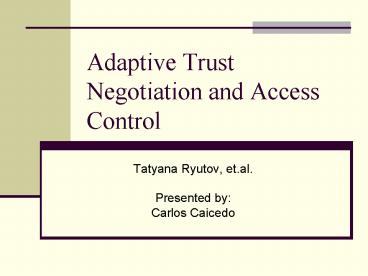Adaptive Trust Negotiation and Access Control PowerPoint PPT Presentation
Title: Adaptive Trust Negotiation and Access Control
1
Adaptive Trust Negotiation and Access Control
- Tatyana Ryutov, et.al.
- Presented by
- Carlos Caicedo
2
Introduction
- Electronic business transactions
- Parties in transaction dont know each other
- Attacks can be launched to the transaction
(negotiation) infrastructure - Trust is required for transaction
- For buyers
- Trust that sellers will provide services
- No disclosure of private buyer info
- For Sellers
- Trust that buyers will pay for services
- Meet conditions for buying certain goods (age)
3
Introduction
- In an electronic business transaction,
participants interact beyond their local security
domain. - Proposed framework Adaptive Trust Negotiation
and Access Control (ATNAC) - Combination of two systems into an access control
architecture for electronic business services - TrustBuilder Determines how sensitive
information is disclosed - GAA-API For adaptive access control
4
GAA-API Generic Authorization and
Access-control API
- Middleware API
- Fine-grained access control
- Application level intrusion detection and
response - Can interact with Intrusion Detection Systems
(IDS) to adapt network threat conditions - It does not support trust negotiation and
protection of sensitive policies.
5
GAA-API
6
TrustBuilder
- Trust negotiation system developed by BYU and
UIUC - Vulnerable to DoS attacks.
- Large number of TN sessions sent to server
- Having the server evaluate a very complex policy
- Having the server evaluate invalid or irrelevant
credentials - Attacks aimed at collecting sensitive information
7
ATNAC
- Combines an access control and a TN system to
avoid the problems that each has on its own. - Supports fine-grained adaptive policies
- Protection based on perceived suspicion level
- Uses feedback from IDS systems
- Reduces computational overhead
- Associates less restrictive policies with lower
suspicion levels.
8
ATNAC (2)
- GAA-API
- Access control policies for resources, services
and operations - Policies are expressed in EACL format
- TrustBuilder
- Enforces sensitive security policies
- Uses X.509v3 digital certificates
- Uses TPL policies
9
ATNAC Framework
10
Suspicion Level
- Indicates how likely it is that the requester is
acting improperly. - A separate SL is maintained for each requester of
a service. - Has three components
- SDOS Indicates probability of a DoS attack from
the requester - SIL For sensitive information leakage attempts
- So Indicates other suspicious behavior
- SL is increased as suspicious events occur and
decreased as positive events occur.
11
ATNAC operation
- The Analyzer identifies requesters that generate
unusually high numbers of similar requests and
increment SDoS - In a trust negotiotion process, credentials sent
by client must match credentials requested by the
system otherwise SDoS set to 1. - If either SDoS, SIL or So gt 0.9, the system will
block the requester at the firewall - If SIl gt threshold. Trust Builder will impose
stricter sensitive credential release policies. - As SIL increases, GAA-API uses tighter access
control policies
12
ATNAC operation - example
13
ATNAC operation - example
14
Conclusions
- ATNAC framework for protecting sensitive
resources in e-commerce - Trust negotiation useful for access control and
authentication. - ATNAC dynamically adjusts security policies based
on suspicion level - System protects against DoS attacks on the
service provider - Guards against sensitive information leaks.

